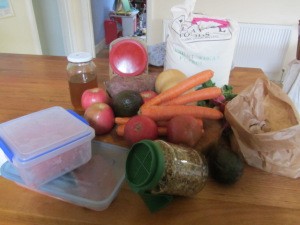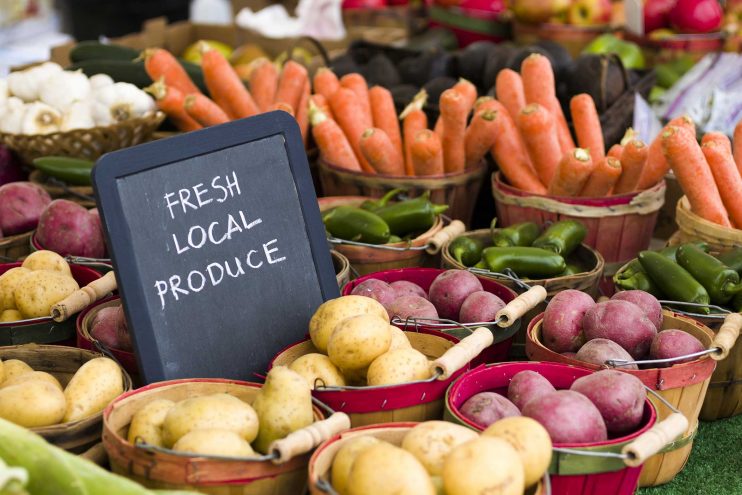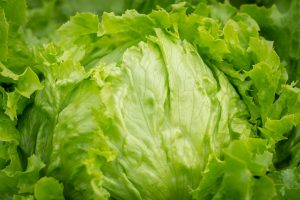Have you ever wanted to try living with a small footprint? This article tells how to do this regarding food: planning, knowing the growers, buying thoughtfully, being canny in the kitchen, and avoiding packaging.
Several years ago my wife, our two young children (aged 1 and 3) and I undertook a year of living lightly. We would consume no plastic, use no oil and live as locally and sustainably as possible for a year. Our aim was to show that, with a bit of planning, anyone can do the same and that, more importantly have more fun doing it. So here’s a little summary of what we learnt with a couple of suggestions to support you in buying more lightly.
1. Plan
People always asked us what was the hardest thing. Whilst our initial answer was (a very honest) “nothing really”, the biggest change we made was to let go of ‘impulsive spontaneity’. A lot of the things that we waste are the things bought on a whim. We buy too much, we often cook too much and particularly if you shop in supermarkets we fall prey to the marketing that encourages us to buy stuff we know we shouldn’t. So number 1 is plan! Write down a menu and what you will need to make it. Get a small whiteboard, stick it to your fridge and write what left-over or bulk stuff you still have (like stock, tomato paste etc). When you’ve finished cooking also note how much you used and whether you need a little more or a little less next time. Fifty percent of Municipal waste is food-waste; yes you can compost but even better is not buying it in the first place. Not only will this reduce your consumption but you will be surprised how much money it saves.

Fresh food shopping
2. Get to know your grower (or at least your vendor)
Most people are separated from the food production system which makes us wasteful consumers and puts us outside natural rhythms or seasons and locality. So shop in places where you can ask questions about what you are buying. How are they grown? When were they harvested? Where are they from? We put a 100 mile radius around our house for all our food (except for coffee!) which meant we had to ask. There are also a couple of spin-offs from doing this. First the more you connect with what you are buying the less likely you are to buy imported Californian orange juice made from concentrate. It’s only the fact we don’t consciously shop that stops our brains from pointing out how completely crazy such a product is! Second, but related, is it will make shopping at large supermarkets the very odd experience it should be, because you realise that what is being sold is not food, just product that is often wrapped in ludicrous amounts of packaging. The last thing is that shopping for stuff that connects with people and land is fun. I will never forget the apple farmer at the local market who spent ten minutes explaining his rationale for moving organic and also described (with taste tests) the different types of apples he was selling (and why). They may well have been amazing apples but buying food with a backstory from the grower makes food taste better, makes you more careful in its use and above all is far more fun to shop for.
3. Buy in bulk
People will often say that buying lightly is more expensive. That is both true and not true. It’s true that often the items are more expensive but the way that you buy them is less expensive. It’s also true that some of our food has been devalued to the point where its cheapness is actually a problem (think for a second how you can get a 99c bottle of tomato passata from Italy when it takes a kilo of tomatoes to make a litre, the bottle itself costs money and it has been shipped half way across the world, not to mention that everyone along the route has made a profit!). So how do you buy real food and not break the bank? Well…
Buy in season. Get to know what is ripe and plentiful when. You will not only save money but the food will be more tasty, more sustainable and your awareness about what grows when will give the year peaks and troughs to look forward to. Check out http://seasonalfoodguide.com/melbourne-victoria-seasonal-fresh-produce-guide-fruits-vegetables-in
Embrace left-overs. Get to know some recipes that make explicit use of left-overs. Fried rice, sausage rolls, shepherds pies, pasta bakes. Lots of dishes can be made with the left-overs from the night before.
Simplify your cooking. If you buy local, fresh and seasonal then there is less need for expensive truffle oil and chunks of gorgonzola (not that these things aren’t yummy) to make up for the grey, bland taste of your produce.
Buy in bulk. There are things that keep for a long time and supermarkets make a great deal more profit on small bag or single use items. Buy things when they are cheap and buy them in bulk. We always have oats, rice, stock, oil, flour and tomato passata/paste in our pantry. Try The Source https://thesourcebulkfoods.com.au or Naked Foods https://nakedfoods.com.au
Make it yourself. Okay this is a bit of an edgy one because in terms of efficiency it’s often more sustainable to have it done in bulk. The one absolute situation where this isn’t the case is where you have produce gluts. If you have plums then make jam, if you have soft fruit (like a persimmon) then make fruit leather. It’s not that hard, makes best use of produce that could be wasted and is fun.
4. Buy food not plastic
This is hard for some people and in some places so if it’s not possible then don’t beat yourself up about it. It’s a sad fact that in some places there are fresh food desserts where fast food abounds but fresh food is literally miles away. But use farmers markets, take your own bags, buy in bulk stores, join a CSA (community supported agriculture) or box scheme and try and avoid packaging, plastic bags and supermarkets. We went through weeks of very polite battle with our fishmonger who just couldn’t understand that it was even possible to put ‘that’ fish into ‘this’ tupperware without a single-use plastic which just goes to show how out of the mind the idea of fresh food without plastic can be.
What next?
I know this all sounds hard but when our year was up we simply continued on because we discovered that with a little planning it is possible to make some steps towards reducing our consumption which will help our health, our wealth and also our planet. Good luck and don’t forget to take your time and have some fun!


